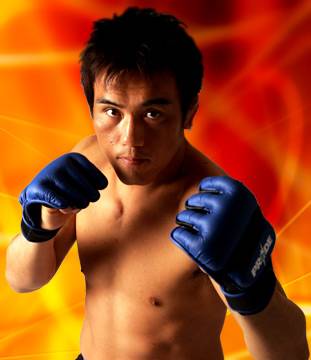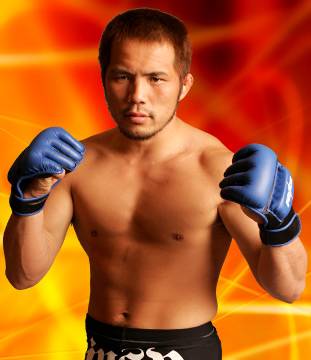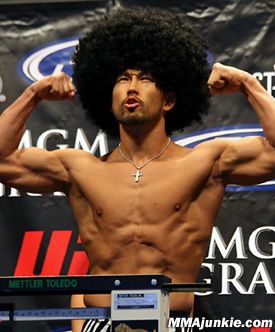That’s Judo! If you go back and watch Karo Parisyan’s fights, this is a word you will hear about 7 times per round. When he hit the scene in the early 2000s, Judo was not well-represented on the North American MMA scene. In terms of cage fighting, US fans dismissed this art as limited and didn’t see it as useful. Karo Parisyan was born in Armenia, and immigrated to America when he was six years old, in 1988. At the age of nine, he started training in Northern Hollywood under Gokor Chivichyan and Gene LeBell, who developed the Hayastan Grappling System. Between 2000 and 2003, Karo competed at the junior national level, winning 10 titles across the US and Canada. Five of those were gold medals. Karo made his MMA debut in 1999 and competed throughout the time he was winning Judo championships, getting his call from the UFC in 2003. Karo has stated that his interest in MMA always came second to Judo, only fighting to keep himself busy when he wasn’t competing in the former. Going to the Olympics was his dream and he competed in the 2004 Olympic Trials, but fell short of his goal. Thus, he continued his fighting career. Although he didn’t win a UFC title, he became the WEC welterweight champion, and went on to have a very successful career in multiple organizations. Karo became a sort of pioneer for Judo in MMA, and is now remembered for the uniqueness of his style, the Judo skill he displayed, and memorability of his fights. On top of that, he had quite the explosive personality, dividing fans and critics, but always spoke from his heart, and I appreciate that part of who he is. He was often humorous in his post-fight interviews, once even singing about himself to the tune of the US National Anthem from Borat, after his win over Josh Burkman.
The natural Joe Rogan response of “You’re singing sucks, but you’re a fantastic fighter” couldn’t have been more fitting. In terms of Karo’s Judo, I am not an expert so I will just talk about some of the techniques he used, and show you what made him exciting to watch. He quickly compiled a 5-0 record as a professional in less than a year. By the time he got the call from the UFC he was 9-2 overall, with his only losses coming to the future UFC champion Sean Sherk. He debuted at UFC 44 against Dave Strasser, who was an experienced and well respected fighter. Here he is utilizing a Seoi Otoshi or “shoulder drop”. He drops to his knees and pulls Strasser by his arm and shoulder, flipping Strasser over his back.
Here is a Harai Makikomi, which is a hip throw. He uses Strasser’s own forward motion against him, locking in a kimura grip to control his upper body.
He finishes the fight in the second round by using a Hikikomi Gaeshi, or “pulling in sacrifice throw”. This results in Strasser being flipped by Karo’s right foot, and since Parisyan already had a kimura lock, Strasser fell right into the submission and was forced to tap.
He was also able to pull this off against a debuting GSP and almost achieved a straight armbar. It turns out GSP was already freakishly strong in his early days, and he wiggled out.
He would lose to future all-time great GSP. After a 5-1 run in the UFC, he faced Diego Sanchez, who famously said “he won’t be able to take me down with any of that judo crap”. Karo was a small favorite over Sanchez, who came in undefeated in his MMA career, and held a strong wrestling base. Well he did take Diego down with his “judo crap”, but the fight turned out to be one for the ages. Two minutes into the fight, Karo showed us an Ouchi Gari, or “large inner reap”:
After Diego proved tough to keep down, the two clinched a bit. That’s when Karo hit a Harai Goshi, using his arm to control upper body, his leg to sweep Diego’s own, and his hips to flip him forward:
When both guys neutralized each other on the ground, they went to war on the feet, before Parisyan took Diego down again:
This time Parisyan used a Sukui Nage, or “scooping throw”. Diego would prove to be too skilled to be here for long, as he reversed the position and ended the fight on top raining down heavy shots. Sanchez would go on to win a unanimous decision.
Karo Parisyan wasn’t just skilled in the Judo department, although it was his strength. He never hesitated to throw heavy shots and engage in war on the feet. He threw a mean overhand right, often throwing it to close distance, or throwing it upon exiting the clinch. He even used his right hand to feint an overhand, then using it for an underhook to get a throw or set one up. He launched strikes with complete impunity, knowing that if he got taken down, he had plenty of weapons there too. Karo was a complete grappler, and had an understanding of Brazilian Jiu Jitsu and ground positioning. He often transitioned between the two, adding in punches, elbows, and submission attempts.
Here’s Karo hitting an Ippon Seoi Nage on fellow Judo practitioner Dong Hyun Kim at UFC 94:
The Ippon Seoi Nage is a throwing technique. We see Karo use both hands here to pick Stun Gun up by his right arm and throw him over his shoulder, landing on his back.
Here he is again using an Ashi Guruma. Karo presses the calf of his lead leg into Josh Burkman’s quadricep muscle, uses his upper body to rotate Burkman, simultaneously flipping him onto the canvas.
Ninja shit.
When Karo faced Matt Serra at UFC 53, he exchanged strikes with Serra before catching a kick and taking him down. He lands heavy shots while postured up. Once Matt is able to get up, Karo follows, landing punches while trying to control his base (notice the slap Karo landed at 0:41 of the round). He then takes Serra’s back and transitioned to mount, all while raining down some serious ground and pound.
I’d say this clip virtually sums up what the essence of prime Karo Parisyan brought to the table:
It’s a shame Karo was plagued by injuries throughout his career. The hamstring injury he sustained when training for a potential title fight with Matt Hughes was the beginning of the end for Parisyan at the top of the food chain, and he would start to decline after his loss to Thiago Alves in 2008. A lifetime of fighting and getting thrown on your head can shorten your body’s window for top level competition. Parisyan’s last fight in the UFC was at UFC 123, when he lost to Dennis Hallman by first round TKO in 2010. He continued to compete in MMA and after a loss to Jose Diaz in 2017 in a comeback fight, he retired for good. What I find most impressive about his skill set is his ability to implement Judo in his fights. Whether he was moving forward or backpedaling, clinching or striking, he found a way to make Judo work within the chaos of combat, at times seemingly at the most unlikely of moments. If you were fighting him, you were never safe, and always had to fight knowing you could get dumped on your head at any time. The chances are remote that we ever see a fighter like Karo Parisyan in MMA ever again.
References
Special shout outs to Sonny Brown, whose video on Karo Parisyan helped me write this article.
- Sonny Brown. “Judo Throws in MMA – A Study of Karo Parisyan”. YouTube, 2 October 2018, https://www.youtube.com/watch?v=n9odlO7y9Mg&ab_channel=SonnyBrown. Accessed 10 February 2025.










